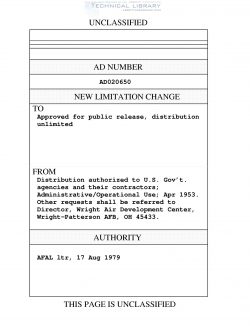WADC-TR-53-106
- Version
- 191 Downloads
- 5.75 MB File Size
- 1 File Count
- March 7, 2017 Create Date
- March 7, 2017 Last Updated
Wright Air Development Center - Tensile and Tensile Fatigue Properties of Transparent Enclosure Attachments for Aircraft

Fifteen types of edge attachments, eight for monolithic acrylic material and seven for laminated acrylic material were desigled, fab— ricated and tested for tensile strength at temperature and -650F, and in tensile—fatigue at room temperature. Thirteen of these types were desi.5ied using acrylic material and two were desißled using acrylic material. Though ultimate t,ensile strengths vary widely depending on and materials used in the attaching edge, it appears that the tensile— fatigue limit in all cases where good engineering desigi practices are maintained approaches one pound per nül thickness per inch of width of transparent acrylic material at. 500,000 cycles. Although acrylic material appears to have a slightly greater endurance limit, insufficient data are available to definitely draw such a con— clusion.
Late In World War Il it beca.me apparent that transparent enclosures for air—
craft could no longer be attached by the sinle means previously used in unpress—
urized craft. This realization induced a general reaction toward edge reinforce—
ment in the technical sections of all concerns involved. Solutions to the prob—
lem were in many cases Independently evolved and consequently types Of att—
aching edges appeared.
The basic purposes for this attaching edge were threefold:
1. TO Increage bearing strength.
2. To prevent the inception of fracture in the body
of the transparent material.
3. To prevent propogation of fracture from the attach—
ing edge into the body of the transparent material.
The direction of attack to achieve these has been universally giml—
lar in that some attaching edge has been cemented to the transparent enclosure.
The materials used for this punose have varied widely and include cast acrylic
reinforcing strips, rubber extrusions. stainlegg vire screen — acrylic laminates,
square woven Fiberglas cloth—acrylic laminates, and free mon loops. More recent
{novatlons have Included nev veaveg of glass cloth as gatin weaves and unidirect—
ional weaves built into acrylic laminates and synthetic fiber acrylic lam—
inates, most no Orlon and Dacron.
| File | Action |
|---|---|
| WADC-TR-53-106 Tensile and Tensile Fatigue Properties of Transparent Enclosure Attachments for Aircraft.pdf | Download |

Comment On This Post